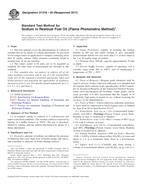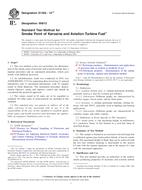Wir benötigen Ihre Einwilligung zur Verwendung der einzelnen Daten, damit Sie unter anderem Informationen zu Ihren Interessen einsehen können. Klicken Sie auf "OK", um Ihre Zustimmung zu erteilen.
ASTM D381-12
Standard Test Method for Gum Content in Fuels by Jet Evaporation
Automatische name übersetzung:
Standard Test Method for Gum in Kraftstoffen von Jet Verdunstungs
NORM herausgegeben am 15.4.2012
Informationen über die Norm:
Bezeichnung normen: ASTM D381-12
Anmerkung: UNGÜLTIG
Ausgabedatum normen: 15.4.2012
SKU: NS-24957
Zahl der Seiten: 6
Gewicht ca.: 18 g (0.04 Pfund)
Land: Amerikanische technische Norm
Kategorie: Technische Normen ASTM
Kategorie - ähnliche Normen:
Die Annotation des Normtextes ASTM D381-12 :
Keywords:
aviation fuels, existent gum, motor gasoline, solvent washed gum, unwashed gum , Automotive engine fuels/oils, Aviation fuels, Evaporation residue, Evaporators/evaporation, Existent gum, Gasoline, Gum content (washed/unwashed), Jet evaporation, Unwashed gum content, Washed gum content, ICS Number Code 75.160.20 (Liquid fuels)
Ergänzende Informationen
| Significance and Use | ||||||||||
|
The true significance of this test method for determining gum in motor gasoline is not firmly established. It has been proved that high gum can cause induction-system deposits and sticking of intake valves, and in most instances, it can be assumed that low gum will ensure absence of induction-system difficulties. The user should, however, realize that the test method is not of itself correlative to induction-system deposits. The primary purpose of the test method, as applied to motor gasoline, is the measurement of the oxidation products formed in the sample prior to or during the comparatively mild conditions of the test procedure. Since many motor gasolines are purposely blended with nonvolatile oils or additives, the heptane extraction step is necessary to remove these from the evaporation residue so that the deleterious material, gum, may be determined. With respect to aviation turbine fuels, large quantities of gum are indicative of contamination of fuel by higher boiling oils or particulate matter and generally reflect poor handling practices in distribution downstream of the refinery. |
||||||||||
| 1. Scope | ||||||||||
|
1.1 This test method covers the determination of the existent gum content of aviation fuels, and the gum content of motor gasolines or other volatile distillates in their finished form, (including those containing alcohol and ether type oxygenates and deposit control additivessee Note 7 for additional information) at the time of test. 1.2 Provisions are made for the determination of the heptane insoluble portion of the residue of non-aviation fuels. 1.3 The values stated in SI units are to be regarded as standard. No other units of measurement are included in this standard. 1.3.1 The accepted SI unit of pressure is the Pascal (Pa); the accepted SI unit for temperature is degrees Celsius. 1.4 WARNINGMercury has been designated by many regulatory agencies as a hazardous material that can cause central nervous system, kidney and liver damage. Mercury, or its vapor, may be hazardous to health and corrosive to materials. Caution should be taken when handling mercury and mercury containing products. See the applicable product Material Safety Data Sheet (MSDS) for details and EPA’s websitehttp://www.epa.gov/mercury/faq.htmfor additional information. Users should be aware that selling mercury and/or mercury containing products into your state or country may be prohibited by law. 1.5 This standard does not purport to address all of the safety concerns, if any, associated with its use. It is the responsibility of the user of this standard to establish appropriate safety and health practices and determine the applicability of regulatory limitations prior to use. For specific warning statements, see 6.4, 7.4, and 9.1. |
||||||||||
| 2. Referenced Documents | ||||||||||
|
Ähnliche Normen:
Historisch
1.5.2013
Historisch
1.5.2011
Historisch
1.11.2012
Historisch
1.5.2013
Historisch
1.7.2014
Historisch
1.6.2011
Empfehlungen:
Aktualisierung der Gesetze
Wollen Sie sich sicher sein, dass Sie nur die gültigen technischen Vorschriften verwenden?
Wir bieten Ihnen Lösungen, damit Sie immer nur die gültigen (aktuellen) legislativen Vorschriften verwenden könnten.
Brauchen Sie mehr Informationen? Sehen Sie sich diese Seite an.



 ASTM D1094-07(2013)..
ASTM D1094-07(2013).. ASTM D1318-00(2011)..
ASTM D1318-00(2011).. ASTM D1322-12e2
ASTM D1322-12e2 ASTM D1405/D1405M-08..
ASTM D1405/D1405M-08.. ASTM D1655-14
ASTM D1655-14 ASTM D1796-11e1
ASTM D1796-11e1
 Cookies
Cookies
